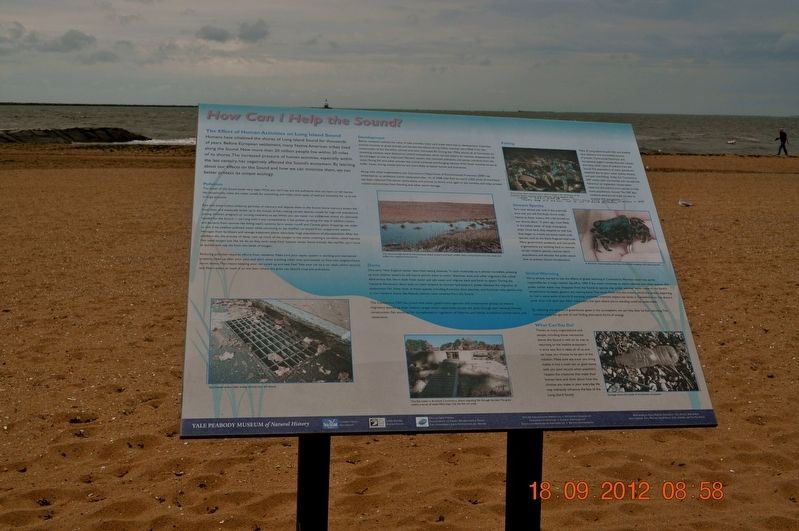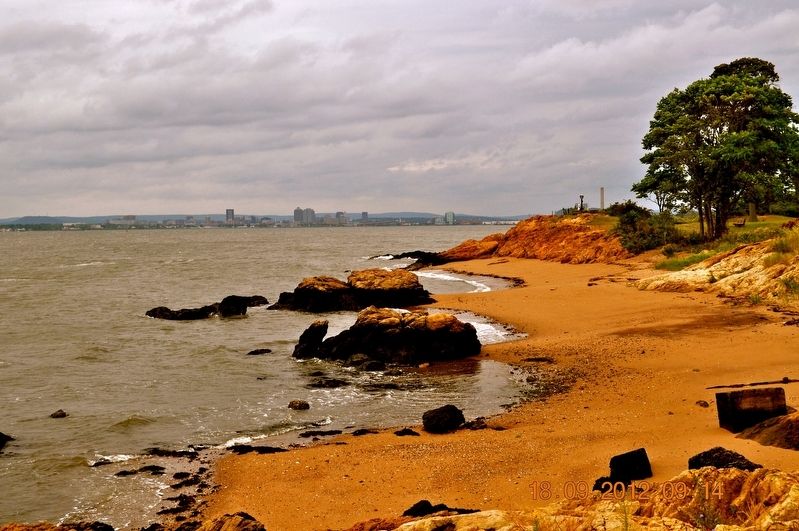How Can I Help the Sound?
The Effect of Human Actives on Long Island Sound
Humans have inhabited the shores of Long Island Sound for thousands of years. Before European settlement, many Native American tribes lived along the Sound. Now more than 20 million people live within 50 miles of its shores. The increased pressure of human actives, especially within the last century, has negatively affected the Soundís ecosystem. By learning about our effects on the Sound and how we can minimize them, we can better protect its unique ecology.
Pollution
The water of the Sound looks very clean. What you canít see are the pollutants that can harm or kill marine life, occasionally make the water unsafe for swimming, and make some types of seafood unhealthy for us to eat in large amounts.
Rain and snow collect airborne particles of mercury and deposit them in the Sound. Some mercury enters the food chain and eventually builds up in the tissue of fish, making certain species unsafe for high-risk populations (young children, pregnant or nursing mothers) to eat. When you see water into street drains, itís ultimately headed for the Sound - carrying with it any contaminants it has picked up along the way. In addition, toxins and bacteria from sources like failing septic systems, farm waste runoff, and Canada geese droppings can make us sick
if we swallow polluted water while swimming or eat shellfish harvested from unapproved waters.Nitrogen from fertilizers and sewage treatment plants stimulate huge populations of phytoplankton. After the plankton die, the process of decay uses up much of the oxygen in the water, creating a condition called hypoxia. Fish need oxygen just like we do, so they swim away from hypoxic zones. Some animals, like starfish, canít move as quickly and may die form lower levels of oxygen.
Reducing pollution requires efforts from residents. Make sure your septic system is working and maintained properly, clean up after your pets, and donít allow anything other than stormwater to flow into neighborhood storm drains, that means keeping your car tuned up and leak free! Take your can to a car wash, which recycles and filters water, or wash it on the lawn where the grass can absorb soap and pollutants.
Development
Before residents realized the value of tidal marshes, many such areas were lost to development. Colonists drained marshes to graze animals and harvest the salt marsh hay.
Other marshes were filled in for the construction of the shoreline railroad and, laterInterstate-95. During the 1930s, almost all of Connecticutís remaining marshes were drained to control mosquitoes, which carried malaria. As marshes disappeared, the Sound began to lose an important filtration
Along with other organizations, the Connecticut Department of Environmental Protection (DEP) has embarked on an ambitious march restoration plan. As of 2008, tidal flow to nearby 2,025 acres of marshland has been restored. This allows native plants and animals to thrive once again in the marshes, and help protect coastal communities from flooding and other storm damage.
Dams
One early New England settler described seeing alewives “in such multitudes as is almost incredible, pressing up such shallow waters as will scare permit them to swim.” Alewives, shad, and other migratory fish called diadromous fish, live in both fresh water and salt water, and migrate back and forth to spawn. During the Industrial Revolution dams built on many streams to harness hydroelectric power blocked the migration of diadromous fish. Now most of these species, including American shad, alewives, and American eels, persist only in low numbers. Some, like Atlantic salmon, have vanished from the Sound.
The Connecticut DEP has joined with other government agencies and conservation groups to restore migratory species
to their historic range within watersheds across the state through dam removal, fishway construction, fish stocking, fish transplantation, regulation of fisheries and habitat protection, conservation, and restoration.
Fishing
Many of Long Island Soundís fish and shellfish taste delicious and are healthy sources of protein. Commercial fishermen and recreational anglers harvest flounder, lobster, and many other types of seafood from the Sound. The populations of many species are depleted due to poor water quality, disease, and past overfishing. Today the Connecticut DEP works with commercial and recreational fishermen to implement conservation measures and enforce strict quotas to help these populations recover. The DEP also conducts semi-annual trawl surveys to monitor fish population.
Invasive Species
Turn over almost any rock in the intertidal zone and you will find Asian shore crabs. Native to Asia waters, this crab arrived on our shores about 15 years ago, most likely in the ballast water of large oceangoing ships. Once here, they adapted so well the they began to crowd out some native crab species, such as the black-fingered mud crab. Many government, academic, and non-profit organizations are working hard to remove certain invasive species, restore native populations and educate the public about how to prevent future introductions.
Global Warming
Weíve already started to see the effects of global warming in Connecticut. Warmer water was partly responsible for a major lobster die-off in 1999. If the water continues to ware, lobster and other species that prefer colder water may disappear from the Sound as species that prefer warmer water move in.
As Earthís temperature increases, glaciers are melting faster. This water flows into the ocean, which are already beginning to rise in some parts of world. If warming continues, scientist expect seal leaves in Connecticut to rise about a tenth of an inch each year. After many years the spot where youĎre standing could be underwater.
What can you Do?
Thanks to many organizations and people, including those mentioned above, the Sound is well on its way to returning to the healthy ecosystem it once was. But it takes all of us, and we hope you choose to be part of the solution. Mark sure any trash you bring makes it into a trash can or goes home with you (recycle when possible)!, respect the creatures that make their homes here and think about how the choices you make in your everyday life may indirectly influences the fate of the Long Island Sound.
Pictures
Stormwater drains often empty directly into the Sound.
The fish ladder in Branford, Connecticut, allows migrating fish through the dam. The grate covers a series of water-filled steps that the fish can jump
Erected by Yale Peabody Museum of Natural History.
Topics. This historical marker is listed in these topic lists: Animals • Environment • Hispanic Americans. A significant historical year for this entry is 2008.
Location. 41° 14.934′ N, 72° 54.213′ W. Marker is in New Haven, Connecticut, in New Haven County. It is in East Shore. Marker is on Lighthouse Road. Marker is located at Lighthouse Point Park. Touch for map. Marker is at or near this postal address: 2 Lighthouse Road, East Haven CT 06512, United States of America. Touch for directions.
Other nearby markers. At least 8 other markers are within 2 miles of this marker, measured as the crow flies. The Butterfly Garden at Lighthouse Point Park (here, next to this marker); So Who Lives Here, Anyway? (here, next to this marker); Winged Migration (here, next to this marker); Near This Spot (within shouting distance of this marker); Roll of Honor (approx. one mile away); In Memory of George Pardee (approx. 1.1 miles away); Fort Nathan Hale (approx. 1Ĺ miles away); Patriots of New Haven Memorial (approx. 1Ĺ miles away). Touch for a list and map of all markers in New Haven.
Credits. This page was last revised on February 10, 2023. It was originally submitted on August 22, 2017, by Sandra Hughes Tidwell of Killen, Alabama, USA. This page has been viewed 171 times since then and 5 times this year. Photos: 1, 2. submitted on August 22, 2017, by Sandra Hughes Tidwell of Killen, Alabama, USA. • Bill Pfingsten was the editor who published this page.

